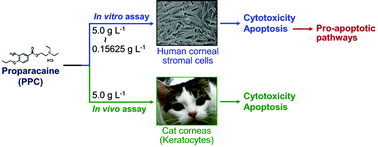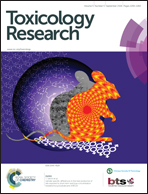Proparacaine induces cytotoxicity and mitochondria-dependent apoptosis in corneal stromal cells both in vitro and in vivo†
Abstract
Proparacaine (PPC) is a widely used topical anaesthetic in the eye clinic; its abuse may damage the cornea and result in impairment of vision. Although PPC has been reported to be cytotoxic to human keratocytes, there is no scientific report about its toxic mechanisms in human corneal stroma. Here, we evaluated the cytotoxicity of PPC to corneal stroma in an in vitro model of human corneal stromal (HCS) cells and an in vivo model of cat corneas. To postulate the cellular and molecular mechanisms involved in PPC toxicity, changes in the hallmarks of apoptosis as well as in pro-apoptotic signaling pathways were investigated. Our results showed that PPC at concentrations varying from 5.0 to 0.15625 g L−1 induced dose- and time-dependent cell atrophy, vacuolation, cytopathic effects, and viability decline in vitro. Moreover, PPC induced G1 phase arrest, plasma membrane permeability elevation, phosphatidylserine externalization, DNA fragmentation, chromatin condensation, and apoptotic body formation of HCS cells. Furthermore, PPC could induce caspase-2, -3 and -9 activation, and mitochondrial transmembrane potential disruption. Expression of Bcl-xL and Bax were downregulated and upregulated, respectively, and cytoplasmic cytochrome c and apoptosis inducing factor were upregulated remarkably after PPC treatment. The cytotoxicity and pro-apoptotic effects of PPC were also proven by induced corneal edema, apoptotic-like ultrastructural alterations and DNA fragmentation of keratocytes in cat corneas in vivo. These results suggest that PPC above 1/32 of its clinical dosage has remarkable cytotoxicity to corneal stromal cells, which is achieved by inducing death receptor-mediated mitochondria-dependent apoptosis of HCS cells.



 Please wait while we load your content...
Please wait while we load your content...